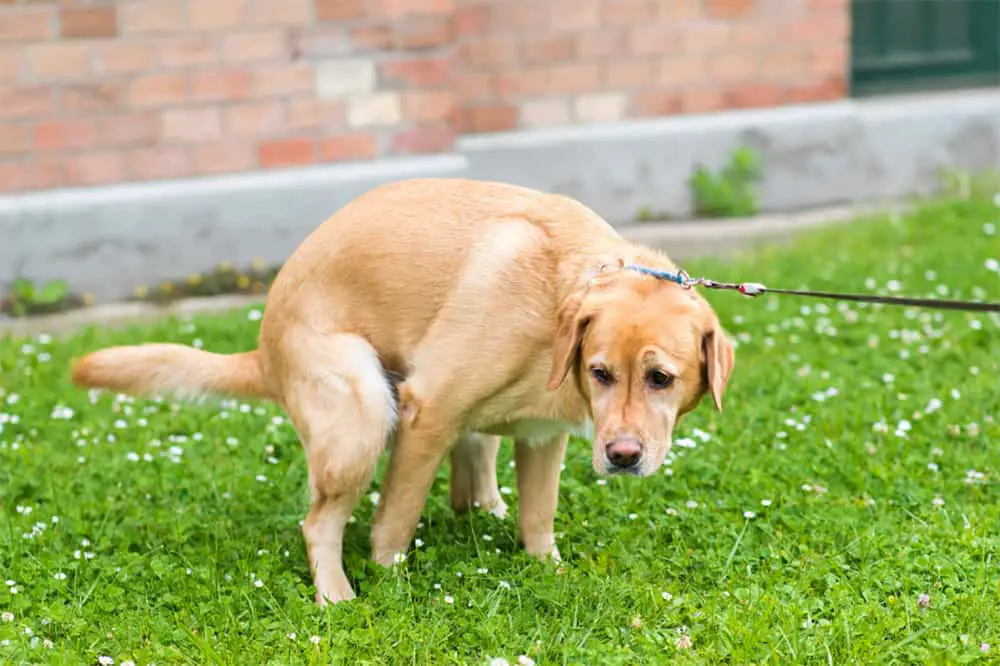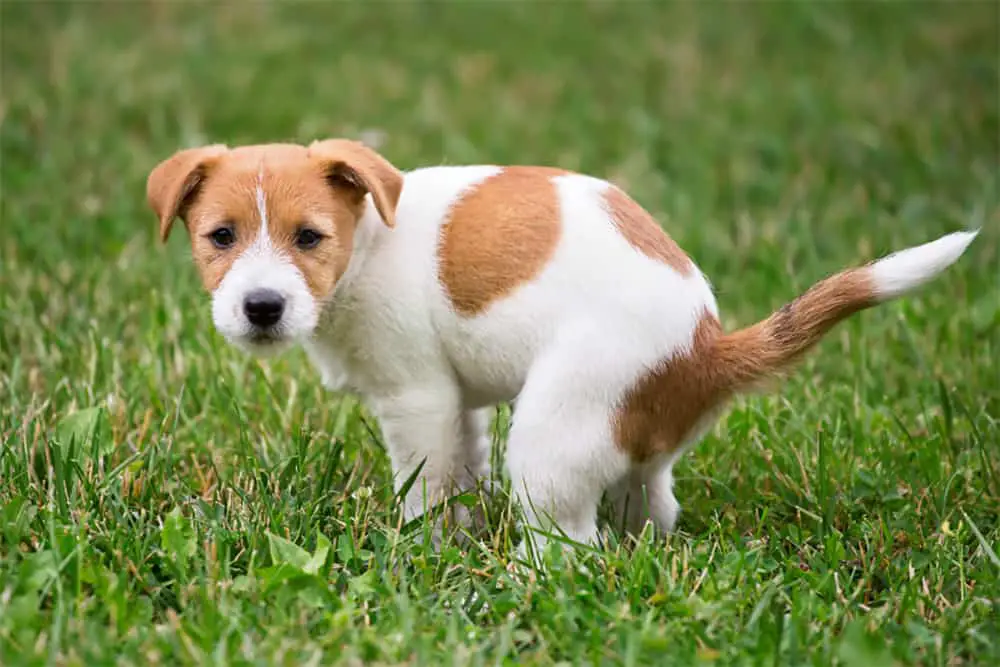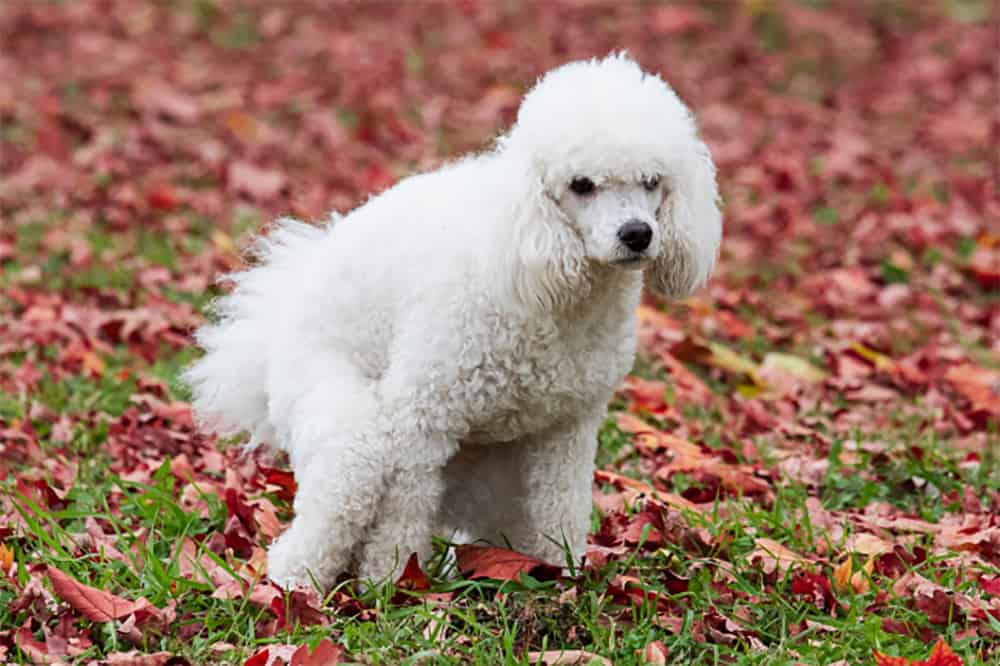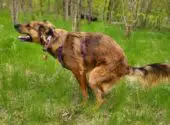When it comes to your dog and its digestive system, it is a topic you need to be educated on. While it is not a pleasant topic to discuss, it is important for you to have a good understanding of your dog’s poop, and what is normal for your dog.
This will then help you to understand and take note of anything within your dog’s stools that are abnormal.
The earlier you spot something that is potentially wrong with your dog’s digestive system and health, the quicker it can be resolved.

In some instances, you may have noticed that your dog has passed something in its stool that is jelly like, with a mucus consistency.
It is only natural to be concerned and wonder what this may be, to help you get to the root of this issue. After all, this should not be a normal occurrence for any dog.
In this article, we will be discussing the potential causes of this, and what you can do as an owner to help resolve this issue.
How To Spot Jelly Mucus?
It is fairly easy to spot jelly mucus in a dog’s stool, as it looks exactly like how it sounds. However, in some cases the mucus like jelly can be red, green, or yellow. If the mucus is this color, it could potentially be the sign of something more serious.
The jelly mucus is typically found within the stool, or it can also be coating it too, depending on how much of it is present. Sometimes there may only be a small amount of mucus, however, in some cases there may be a significant amount.
In general, a small amount of mucus present in a dog’s stool is normal and a sign that the dog’s digestive system is functioning as it should. However, if there is an excess amount of mucus, this could potentially be the sign of a problem.
Should I Take My Dog To The Vets?
If you are ever concerned about your dog and its health, we would always recommend paying a visit to your local vets in order to have your dog checked over. This will not only help to give you peace of mind, but the veterinarian can then rule out potential causes.
In some cases, if the mucus looks as though it is a healthy amount, and your dog is not showing any signs of distress, there may not be any need to do this.
However, even if your dog is healthy and the stools look normal, you still want to keep a close eye on them. That way, if there are any sudden or gradual changes, you will be able to notice these and act accordingly.
The benefit of taking your dog to the vets if you are unsure is that they can run tests on fecal samples. This will help to rule out any serious conditions, and from here they will be able to advise on the best solution for your dog – whether this is through treatment or diet change.
If the mucus found in your dog’s poop is not clear, and is red, green, or yellow, this can be a sign of a more serious issue or an infection. In this instance it is certainly worth contacting your vet as soon as possible to discuss this with them.
What Jelly Mucus In Dog Poop Might Mean?
There are a few different reasons behind why your dog has jelly mucus. This is why it is always important to get to the root of the problem.

As we have already discussed, a small amount of jelly mucus in a dog’s stool is normal, but it can also potentially be a sign of underlying illnesses.
IBS And IBD
One of the most common reasons why a dog may have jelly mucus in their stool is due to IBS. This stands for Irritable Bowel Syndrome, and it is something that you may have heard of.
When it comes to IBS, it is difficult to know the exact cause of it, this is why it can be more difficult to treat. However, it is a manageable condition, and one that fortunately, is not too serious.
IBS causes irritation within the digestive system, particularly within the small and large intestines.
Some of the symptoms it can cause include diarrhoea, constipation, bloating, cramping, and abdominal pain. In some cases, it can lead to your dog vomiting too.
When these symptoms occur, it causes pain and tenderness within the digestive tract, and often the intestines can become inflamed. A dog’s immune system naturally responds to this by producing more mucus.
The mucus then helps to soothe the digestive tract, by making it easier for the dog to pass stools. It also helps to prevent damage to the intestines, and allows them time to heal. It is a natural protector.
As a result of this, if your dog is experiencing a flare up linked to IBS, it is not uncommon for them to pass more jelly mucus in their stools. It is worth noting that in some cases, small amounts of blood can be present in the stool with IBS.
In addition to IBS, IBD is something dogs can suffer from too. This stands for inflammatory bowel disease, and it can be more serious. IBD needs to be carefully managed and diagnosed by a vet. Typically, they will provide a special diet, and medication to help with the symptoms of this.
Diet
Following on from IBS, diet is typically closely linked with this. As a result you will want to ensure that you are feeding your dog a diet that is correct for them. This is especially important if your dog has been diagnosed with any allergies or with IBS.
For example, if your dog is suffering from intolerances to grains, and you continue to feed them food with grain added, this will have a negative impact on their digestive system.
This can then cause it to respond by producing excess amounts of mucus. In addition to this, it could even lead to blood in the stools.
Feeding your dog a good quality diet, this is full of protein and low on additives and fillers, is important. Dogs do not naturally consume grains, and as a result, their digestive system finds it a lot more difficult to digest these ingredients.
If your dog has a sensitive stomach, it is best to feed a grain-free food that is easier on their digestive system.
For IBS or other specific digestive issues, your vet may prescribe or suggest a specific food for them to consume. There are many types of hypoallergenic foods available.
When it comes to the types of food given to dogs, if you are changing its diet, you will need to do this gradually.
If you change a dog’s diet too quickly, this can cause mucus in the stool and an upset stomach. This is because the dog is not used to the food, and it is a sudden change.
To prevent this, you will want to change the food gradually over the course of two weeks, slowly mixing in more of the new food with the old.
Hemorrhagic Gastroenteritis
If the jelly like mucus in your dog’s stool is very bloody, this can be a sign of a more serious issue. In this instance, we would recommend that you have a chat to your vet about this.
When there is bloody mucus with the consistency of jelly, this can be a sign of a condition known as hemorrhagic gastroenteritis.
This is sometimes referred to as HGE. HGE can quickly become a serious and life-threatening issue, which is why you need to keep a close eye on this type of mucus.
While it is something that can be treated, the issues lie when it is not correctly treated. This is why it is important to flag up this issue when it is noticed. In addition to the mucus, you will notice that your dog will potentially vomit too.
Anxiety
It is quite common for a dog to suffer from anxiety. This anxiety can present itself in many different forms, from separation anxiety, to anxiety around new people.
There are many things that can trigger anxiety for a dog, and no two dogs will experience it exactly the same.

As a result of this, it can be fairly difficult to pinpoint the causes of anxiety in a dog, especially if it is something they have recently developed. Anxiety can present itself in many ways, such as nervousness, shaking, and body language.
In addition to this, it can also affect a dog’s digestive system. It typically causes diarrhea, which can be unpleasant for a dog.
Diarrhea can cause excess mucus to be produced, and this can be spotted with blood if it is particularly painful for the dog. Where possible, you will want to address the issues that are linked with anxiety and try to help alleviate this.
From here, you will then be able to better manage your dog’s digestive system and overall health.
Parasites
In some cases, jelly mucus can be an indication that your dog is suffering from parasites.
This is something that is easily treatable, but needs to be addressed as soon as possible. If parasites are not addressed, this can lead to complications, discomfort and illness within a dog.
Luckily the vast majority of parasites can be prevented and removed fairly easily. It is important to use worming and parasite treatment regularly to help ensure that your dog is free from any of these.
The majority of treatments are given every one to three months. They work quickly and effectively.
Bacterial Infections
In some cases, bacterial infections can be the cause of excess jelly mucus in a dog’s stool. These need to be addressed by a vet and treated correctly.
Dogs will typically pick up these infections by eating things that are full of bacteria. Food that has gone bad is a common cause of this. For example, bad meat can carry E. coli, or salmonella which can make a dog severely ill.
It is important to ensure that your dog doesn’t eat anything it shouldn’t, especially when it comes to old food, or things left on the floor when you are walking your dog.
Dogs are known to eat things they shouldn’t, especially when they are puppies. Keeping a close eye on them, and keeping them away from rubbish or things they shouldn’t eat, is essential.
Summary
We hope you have found this article useful. As you can see, there are many reasons why a dog may experience jelly mucus. While a small amount of mucus is healthy and nothing to be concerned about, if there is an excess amount, it is always best to book an appointment with your vet.
While mucus is healthy, bloody mucus is not, and too much can be a sign of an underlying health issue. The best option is to have serious issues ruled out or treated, and the sooner these are resolved, the better.
Fortunately many of the conditions that we have stated above are completely manageable, and your dog can be treated for them. Even so, while examining your dog’s stools is something that isn’t pleasant, it is important to do.
This will help you to spot any potential issues as early as possible.




